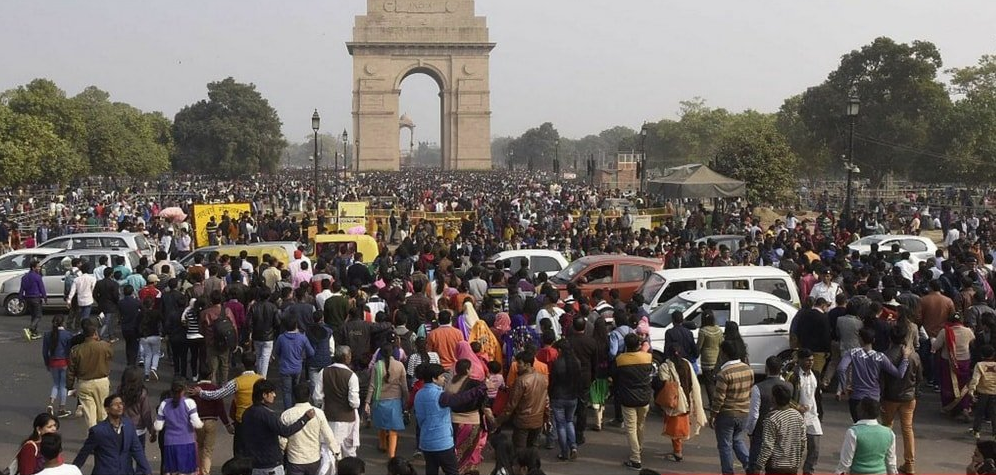Today, the 11th July, on the World Population Day, I wonder if anyone of us and the law makers have a little time to spare and delve a bit deeper to plan and find solutions to the ever Bloating population of India.
The data from the Department of Economic and Social Welfare reveals that the country’s population has multiplied alarmingly @almost four times from 40.92 crore in 1955 to 135.43 crore today. During the same period the world’s population increased less than three times, from 272 crore to 763 crore. India’s population is thus 17.74 percent of the world population which means that every sixth person on this earth is an Indian. On the contrary many countries in the world are witnessing negative growth year after year.
What is more alarming is that the density of population in the country has increased in leaps and bounds from 138 persons per sq. km in 1955 to 455 in 2018. And in comparison with the World’s most populous country, namely China, it is 3 times. In other words, China’s geographical territory is three times that of India. While the figure is in percentage to the total area of the country, the actual brunt is borne in the urban areas where satellite images show people moving like a colony of ants on the earth. Presently more than 32 percent of the country’s population lives in cities which is going to increase to 49 percent in 2050 thereby further adding to the pressure in cities.
Densely populated cities means increase in the demand for housing which in turn means more deforestation to build multi-storeyed skyscrapers that leads to depletion in the water table as the need for underground water will increase, more traffic snarls leading to road fury and accidents and so on and so forth. Overpopulation is at the root cause of various evils that seem to be on the rise in our country today.
The only solace for the decision making governments is in the slowing down of growth rate which has declined from 1.69 percent in 1955 to 1.11 percent, as well as the total fertility rate which has declined from 5.90 to 2.4 today. But should we be contented with this creeping rate of decline?
At the current rate of growth India is slated to be the World’s most populous country at 145 crore by 2025 grabbing the number 1 position from China. As per the projections, by 2050 the country’s population will have risen to 165 crore though the growth rate will further reduce from 1.11 percent today to 0.27 percent while the fertility rate is also expected to come down from 2.4 to 1.86. The falling rates of fertility in India may not be a true solace as any rate of 2.0 plus will only add up to the numbers while the longevity of individuals has been increasing, thanks to the health care facilities made available.
But are the successive governments merely resting on the projections of slowing down of growth rate and fertility rate?
With rapidly multiplying population of over 135 crore, the country’s politicians might be stuck at crossroads how to continue appeasing the enormous numbers with doles at the cost of actual productivity growth.
With ever growing numbers no amount of budget is going to suffice to feed the dependent bellies. It is also true that with numbers alone the leaders add to their strength and if such numbers are those of the poor, illiterate and always wanting, it is all the better as they can be easily goaded to become blind followers. “You continue to produce children and we will continue to feed them by taxing those who have means,” the underlying implicit assurance appears to be the populist approach.
Undoubtedly with endless doles we are simply raising generations after generations to continue walking on crutches. Not only that, politicians often turn a blind eye to the illegal crossing over from neighbouring countries like Nepal, Bangladesh, Myanmar etc. knowing that these illegal immigrants will also add to their vote bank.
Talking about the strengths of the country, our honourable Prime Minister has repeatedly talked about 65 percent population of youth in India. But let us try to find out what percentage of that population is instrumental in the development of our nation when a major portion remains unemployed and often takes to streets and become detrimental to the growth of the country. The asset becomes a liability if we are not sure how we are going to utilise this enormous workforce.
The ever growing population of youth may turn out to be a big nuisance if we are not able to keep them profitably engaged for we have often heard and it has been proven many a times that an empty mind is a devil’s workshop. Crime will acquire gigantic proportions if the youth is not steered in the right direction with education and suitable employment.
In order to check the menace of galloping population, China had experimented on many an options in the past. From the two-child norm, they had straight away propagated the one- child norm which had effectively put a check on their growth rate.
Some three to four decades ago, the Indian governments had put a major thrust on Family Planning and Family Welfare. A host of incentives to promote small family norms were put in place. Not to talk of the dreaded ‘Sterilisation’ drives of the 70s, the message sent across the nation was a multidimensional approach to contain the growth. And a lot of hue and cry was made as the numbers were inching to touch 100 crore way back in later part of 1990s. But no one seems to be concerned when it has already crossed 135 crore. It means that in some 20 years we have added population equivalent to that existed at the time of Independence.
Unfortunately none of the recent governments is focusing on the issue anymore except organising awareness rallies or cosmetic programmes. The dread of hurting certain religious sentiments may be one of the reasons while the never ending flow of elections in one state or the other also keeps the government abstaining from taking any harsh decisions
No incentives any further, the need of the hour is to devise disincentives to promote the small family and family welfare. No more carrots alone will prove as an effective measure. It is high time that the slogan “The more the merrier” is rewritten as “the fewer the happier” in the context of human population in India.
Having moved on after spearheading corporate communications of a large public sector undertaking, its time to give vent to the creative urges that lay suppressed for long




